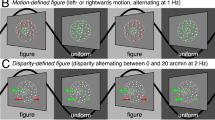Abstract
Behaviourally significant information has often to be extracted from complex distributions of motion signals, which the visual system has to segment into meaningful components. Under special conditions two different motion directions are present simultaneously in the same region of the visual field: a situation called motion transparency. A closer look at the output of motion detector arrays will help us to understand what strategies may be employed in higher motion processing stages to segment the image and how complex distributions of motion directions can be represented. I used motion-defined gratings to investigate what kind of information is represented in the output of a simple two-dimensional motion detector model (2DMD). When motion-defined stripes are wide, the 2DMD output shows clearly separable regions which can easily be detected by spatial filters operating on such motion signals. When the stripes are too narrow to be resolved by such filters, the 2DMD output still reflects the presence of two motion directions, which nevertheless can be discriminated from pure noise. Only if the grain of the moving dots is below the receptive field size of the local motion detectors does the stimulus become indiscriminable from pure noise. These simulation results correspond to the psychophysical observations on segmentation and transparency, and relate well to a processing structure suggested by psychophysical and electrophysiological experiments (see Braddick and Qian, this volume). To understand motion processing we have to consider a variety of mechanisms that may serve to analyse the distributions of local motion signals, from simple spatiotemporal filters to high-level pattern recognition strategies.
Access this chapter
Tax calculation will be finalised at checkout
Purchases are for personal use only
Preview
Unable to display preview. Download preview PDF.
Similar content being viewed by others
References
Adelson EH, Bergen JR (1985) Spatiotemporal energy models for the perception of motion. J Opt Soc Am A 2: 284–299
Albright TD, Chaudhuri A (1989) Orientation selective responses to motion contrast boundaries in Macaque V 1. Soc Neurosci Abstr 15: 232
Allman JM, Miezin FM, McGuinness EL (1985) Direction-and velocity-specific responses from beyond the classical receptive field in the middle temporal visual area (MT). Perception 14: 105–126
Borst A, Egelhaaf M (1989) Principles of visual motion detection. Trends Neurosci 12: 297–306
Braddick OJ (1980) Low-level and high-level processes in apparent motion. Phil Trans Roy Soc Lond B 290: 137–151
Egelhaaf M (1985) On the neuronal basis of figure-ground discrimination by relative motion in the visual system of the fly. II. Figure-detection cells, a new class of visual interneurones. Biol Cybern 52: 195–209
Gibson JJ (1979) The ecological approach to visual perception. Lawrence Erlbaum Associates, Hillsdale, New Jersey
Götz KG (1965) Die optischen Übertragungseigenschaften der Komplexaugen von Drosophila. Kybernetik 2: 215–221
Hildreth E-C, Koch C (1987) The analysis of visual motion: From computational theory to neuronal mechanisms. Ann Rev Neurosci 10: 477–533
Lu Z-L, Sperling G (1995) Attention-generation apparent motion. Nature 377: 237–239
Marr D, Hildreth E-C (1980) Theory of edge detection. Proc Roy Soc Lond B 207: 187–217
Mikami A, Newsome WT, Wurtz RH (1986) Motion selectivity in Macaque visual Cortex. I. Mechanisms of direction and speed selectivity in extrastriate area MT. J Neurophys 55: 1308–1327
Nakayama K (1985) Biological image motion processing: a review. Vision Res 25: 625–660
Nakayama K, Tyler CW (1981) Psychophysical isolation of movement sensitivity by removal of familiar position cues. Vision Res 21: 427–433
Qian N, Andersen RA, Adelson EH (1994a) Transparent motion perception as detection of unbalanced motion signals. I. Psychophysics. J Neurosci 14: 7357–7366
Qian N, Andersen RA, Adelson EH (1994b) Transparent motion perception as detection of unbalanced motion signals. III. Modeling. J Neurosci 14: 7381–7392
Regan D (1991) Spatial vision for objects defined by colour, contrast, binocular disparity and motion parallax. In: Regan D (ed) Vision and visual dysfunction 10 Spatial vision. Macmillan Press, Houndmills, pp 135–178
Reichardt W (1987) Evaluation of optical motion information by movement detectors. J Comp Physiol A 161: 533–547
Sekuler R, Anstis SM, Braddick OJ, Brandt T, Movshon JA, Orban GA (1990) The perception of motion. In: Spillmann L, Werner JS (eds) Visual perception. The neurophysiological foundations. Academic Press, San Diego, pp 205–230
Srinivasan MV, Dvorak RD (1980) Spatial processing of visual information in the movement-detecting pathway of the fly. J Comp Physiol 140: 1–23
Van Doorn AJ, Koenderink JJ (1982) Spatial properties of the visual detectability of moving spatial white noise. Exp Brain Res 45: 189–195
Van Santen JPH, Sperling G (1985) Elaborated Reichardt detectors. J Opt Soc Am A 2: 300–321
Watson AB, Ahumada AJ (1985) Model of human visual-motion sensing. J Opt Soc Am A2: 322–342
Watson AB, Eckert MP (1994) Motion-contrast sensitivity: visibility of motion gradients of various spatial frequencies. J Opt Soc Am A 11: 496–505
Zanker JM (1996) On the elementary mechanism underlying secondary motion processing. Proc Roy Soc Lond B 351: 1725–1736
Zanker JM (1999) Generating Motion-Defined Gratings from Spatially Filtered Random Dot Patterns. Invest Ophth Vis Science 40: S 422
Zanker JM, Hofmann MI, Zeil J (1997) A two-dimensional motion detector model (2DMD) responding to artificial and natural image sequences. Invest Ophthalmol Vis Sci 38: S 936
Zeil J, Zanker JM (1997) A glimpse into crabworld. Vision Res 37: 3417–3426
Author information
Authors and Affiliations
Editor information
Editors and Affiliations
Rights and permissions
Copyright information
© 2001 Springer-Verlag Berlin Heidelberg
About this chapter
Cite this chapter
Zanker, J.M. (2001). Combining Local Motion Signals: A Computational Study of Segmentation and Transparency. In: Zanker, J.M., Zeil, J. (eds) Motion Vision. Springer, Berlin, Heidelberg. https://doi.org/10.1007/978-3-642-56550-2_6
Download citation
DOI: https://doi.org/10.1007/978-3-642-56550-2_6
Publisher Name: Springer, Berlin, Heidelberg
Print ISBN: 978-3-642-62979-2
Online ISBN: 978-3-642-56550-2
eBook Packages: Springer Book Archive




